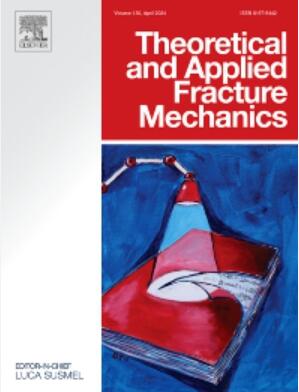废轮胎橡胶和硅灰自密实混凝土双k断裂参数的试验测定
IF 5.6
2区 工程技术
Q1 ENGINEERING, MECHANICAL
引用次数: 0
摘要
为了解决大量废旧轮胎橡胶造成的环境问题,废旧轮胎橡胶往往不受控制地沉积,在混凝土中使用废旧轮胎橡胶,用废旧橡胶颗粒代替一部分天然骨料,似乎是一种有效的方法。同时,必须注意的是,这种作用可能会改变自密实混凝土的许多力学参数,以及自密实混凝土的断裂和开裂行为。为此,对橡胶粉和硅粉自密实混凝土的力学性能和断裂性能进行了研究。共配制了14种自密实混凝土,水胶比为0.4,水泥掺量为450 kg/m3。使用化学外加剂来保持自密实混凝土的理想新鲜性能,并在浇筑试验样品时达到适当的骨料分布。实验程序主要研究自密实橡胶混凝土(SCRC)的断裂韧性。断裂性能采用楔形劈裂试验(WST)来确定,作为三点弯曲试验(3PBT)的替代方法,随后使用双k断裂模型进行描述。试验结果还表明,含有高达15%橡胶屑的混合物在初始和不稳定断裂行为方面都取得了令人满意的结果。直到15%的替换水平,KIc,ini仍然大致等于参考值,最大减少16%。从断裂过程来看,橡胶的加入使SCC的断裂机制由脆性/准塑性转变为准塑性。此外,利用扫描电镜(SEM)和能谱仪(EDS)对界面过渡区(ITZ)进行了分析。微观结构分析证实,由于橡胶颗粒固有的化学不相容性和疏水性,硅灰对改善与橡胶颗粒界面结合的作用有限。本文章由计算机程序翻译,如有差异,请以英文原文为准。
Experimental determination of double-K fracture parameters for self-compacting concrete with waste tire rubber and silica fume
In order to address environmental issues caused by the large amount of waste tire rubber, which is often deposited uncontrollably, its use in concrete, by replacing a portion of natural aggregates with waste rubber particles, seems to be an effective approach. At the same time, it must be noted that such an action will likely change many of its mechanical parameters, as well as the fracture and cracking behavior of self-compacting concrete. With that in mind, mechanical and fracture properties of self-compacting concrete with crumb rubber and silica fume were investigated in this study. A total of 14 self-compacting concrete mixtures were prepared with constant water to binder ratio of 0.4 and a cement content of 450 kg/m3. Chemical admixtures were used to maintain the desirable fresh properties of self-compacting concrete and to achieve adequate aggregate distribution during casting of the test samples. The experimental program focused on determining the fracture toughness of self-compacting rubberized concrete (SCRC). Fracture properties were determined using the wedge splitting test (WST) as an alternative to three-point bending test (3PBT) and were subsequently described using the double K-fracture model. Test results also indicated that mixtures containing up to 15 % of crumb rubber yielded satisfactory results for both initial and unstable fracture behavior. Up to the 15 % replacement level, KIc,ini remains approximately equal to the reference value, with a maximum reduction of 16 %. Considering fracture process, the addition of rubber alters the fracture mechanism of SCC from brittle/quasi-plastic to quasi-plastic. In addition, scanning electron microscopy (SEM) and energy-dispersive spectroscopy (EDS) were used to analyze the interfacial transition zone (ITZ). Microstructural analysis confirmed that the effect of silica fume on improving interfacial bonding with crumb rubber is limited due to the inherent chemical incompatibility and hydrophobic nature of rubber particles.
求助全文
通过发布文献求助,成功后即可免费获取论文全文。
去求助
来源期刊

Theoretical and Applied Fracture Mechanics
工程技术-工程:机械
CiteScore
8.40
自引率
18.90%
发文量
435
审稿时长
37 days
期刊介绍:
Theoretical and Applied Fracture Mechanics'' aims & scopes have been re-designed to cover both the theoretical, applied, and numerical aspects associated with those cracking related phenomena taking place, at a micro-, meso-, and macroscopic level, in materials/components/structures of any kind.
The journal aims to cover the cracking/mechanical behaviour of materials/components/structures in those situations involving both time-independent and time-dependent system of external forces/moments (such as, for instance, quasi-static, impulsive, impact, blasting, creep, contact, and fatigue loading). Since, under the above circumstances, the mechanical behaviour of cracked materials/components/structures is also affected by the environmental conditions, the journal would consider also those theoretical/experimental research works investigating the effect of external variables such as, for instance, the effect of corrosive environments as well as of high/low-temperature.
 求助内容:
求助内容: 应助结果提醒方式:
应助结果提醒方式:


